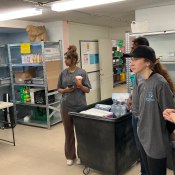
Supporting The Shelters In The City
Supporting shelters in the community for homeless and low-income individuals is a compassionate and impactful way to address the critical issue of homelessness and poverty. Shelters provide vital services, offering safety, food, and resources to those in need. Here are some strategies and actions you can take to provide meaningful support to these shelters:
1. Volunteer:
- Offer your time and skills by volunteering at local shelters or join any of our outreach events to support shelters in the community.
- Common volunteer roles include serving meals, assisting with activities, and organizing events.
2. Donate Goods:
- Collect and donate essential items such as non-perishable food, clothing, blankets, toiletries, and hygiene products. These contributions can make a significant difference in the lives of shelter residents.
3. Financial Contributions:
- Make monetary donations to support shelter operations. Financial contributions help shelters cover operating costs, provide professional staff, and offer comprehensive services.
4. Organize Fundraisers:
- Coordinate fundraisers or crowdfunding campaigns to raise funds for shelters.
- Engage your community and social networks in supporting these efforts.
5. Fundraising Events:
- Plan and host fundraising events, such as charity dinners, benefit concerts, or charity auctions, to raise funds for shelters.
6. In-Kind Support:
- Partner with local businesses to secure in-kind support, such as equipment, furniture, or building materials, to improve shelter facilities.
7. Seasonal Drives:
- Organize seasonal drives, like back-to-school supply drives, holiday gift drives, or winter coat drives, to provide support to shelter residents during specific times of need.
8. Food Drives:
- Coordinate food drives to collect and deliver non-perishable food items to shelters.
- Encourage schools, workplaces, and community groups to participate.
9. Collaborate with Local Restaurants:
- Partner with local restaurants and caterers to regularly provide meals or catering services to shelters.
10. Skills and Training Workshops:
- Offer workshops and training sessions to shelter residents on skills to help them secure employment, manage finances, and transition to stable housing.
11. Advocacy and Awareness:
- Advocate for policies and initiatives that address the root causes of homelessness, such as affordable housing, mental health services, and access to healthcare.
12. Supportive Services:
- Help shelters connect residents to supportive services, such as addiction treatment, mental health counseling, job placement, and legal assistance.
13. Create Outreach Programs:
- Establish outreach programs that identify and assist homeless individuals and families in accessing shelter and support services.
14. Transportation Assistance:
- Provide transportation assistance, such as bus passes or ride-sharing vouchers, to help shelter residents access essential services and job interviews.
15. Personal Mentorship:
- Offer personal mentorship to shelter residents, guiding them in setting goals, finding employment, and accessing resources to transition out of homelessness.
16. Safety and Security:
- Assist shelters in enhancing safety and security measures to ensure the well-being of residents, especially in overnight shelters.
17. Supportive Housing Initiatives:
- Advocate for and support initiatives that provide long-term supportive housing for homeless individuals, addressing the root causes of homelessness.
18. Collaborate with Local Organizations:
- Partner with local organizations, nonprofits, and government agencies to create a comprehensive and coordinated approach to addressing homelessness and poverty.
Conclusion:
By supporting shelters for homeless and low-income individuals, you can make a meaningful impact in your community and contribute to the well-being and dignity of those in need. Whether you volunteer your time, donate goods, or advocate for policy changes, your efforts can help provide essential support and a path to a more stable future for shelter residents.
Recent Posts
InsightHeart Foundation
Younger Volunteers
InsightHeart Foundation
Empowering Kids For School
InsightHeart Foundation



